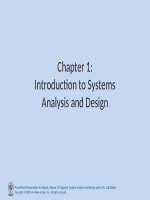Lecture Systems analysis and design with UML (3 e) Chapter 7 Behavioral modeling
Bạn đang xem bản rút gọn của tài liệu. Xem và tải ngay bản đầy đủ của tài liệu tại đây (192.22 KB, 22 trang )
Chapter 7:
Behavioral Modeling
PowerPoint Presentation for Dennis, Wixom, & Tegarden Systems Analysis and Design with UML, 3rd Edition
Copyright © 2009 John Wiley & Sons, Inc. All rights reserved.
Objectives
• Understand the rules and style guidelines for
sequence and communication diagrams and
behavioral state machines.
• Understand the processes used to create
sequence and communication diagrams and
behavioral state machines.
• Be able to create sequence and communication
diagrams and behavioral state machines.
• Understand the relationship between the
behavioral models and the structural and
functional models.
PowerPoint Presentation for Dennis, Wixom, & Tegarden Systems Analysis and Design with UML, 3rd Edition
Copyright © 2009 John Wiley & Sons, Inc. All rights reserved.
Key Ideas
• Behavioral models describe the internal
dynamic aspects of an information system that
supports business processes in an organization
• Key UML behavioral models are: sequence
diagrams, collaboration diagrams, and
statechart diagrams
PowerPoint Presentation for Dennis, Wixom, & Tegarden Systems Analysis and Design with UML, 3rd Edition
Copyright © 2009 John Wiley & Sons, Inc. All rights reserved.
BEHAVIORAL MODELS
PowerPoint Presentation for Dennis, Wixom, & Tegarden Systems Analysis and Design with UML, 3rd Edition
Copyright © 2009 John Wiley & Sons, Inc. All rights reserved.
Behavioral Models
• Systems have static &dynamic characteristics
– Structural models describe the static aspects of
the system
– Behavioral models describe the dynamics and
interactions of the system and its components
• Behavioral models describe how the classes
described in the structural models interact in
support of the use cases.
PowerPoint Presentation for Dennis, Wixom, & Tegarden Systems Analysis and Design with UML, 3rd Edition
Copyright © 2009 John Wiley & Sons, Inc. All rights reserved.
INTERACTION DIAGRAMS
PowerPoint Presentation for Dennis, Wixom, & Tegarden Systems Analysis and Design with UML, 3rd Edition
Copyright © 2009 John Wiley & Sons, Inc. All rights reserved.
Interaction Diagram Components
• Objects
an instantiation of a class
• Operations
the behaviors of an instance of a class
• Messages
information sent to objects to tell them to execute
one of their behaviors
PowerPoint Presentation for Dennis, Wixom, & Tegarden Systems Analysis and Design with UML, 3rd Edition
Copyright © 2009 John Wiley & Sons, Inc. All rights reserved.
Sequence Diagrams
• Illustrate the objects that participate in a usecase
• Show the messages that pass between objects
for a particular use-case
PowerPoint Presentation for Dennis, Wixom, & Tegarden Systems Analysis and Design with UML, 3rd Edition
Copyright © 2009 John Wiley & Sons, Inc. All rights reserved.
Sequence Diagram Syntax
PowerPoint Presentation for Dennis, Wixom, & Tegarden Systems Analysis and Design with UML, 3rd Edition
Copyright © 2009 John Wiley & Sons, Inc. All rights reserved.
More Sequence Diagram Syntax
PowerPoint Presentation for Dennis, Wixom, & Tegarden Systems Analysis and Design with UML, 3rd Edition
Copyright © 2009 John Wiley & Sons, Inc. All rights reserved.
Sample Sequence Diagram
PowerPoint Presentation for Dennis, Wixom, & Tegarden Systems Analysis and Design with UML, 3rd Edition
Copyright © 2009 John Wiley & Sons, Inc. All rights reserved.
Steps to Build Sequence Diagrams
1.
2.
3.
4.
Set the context
Identify which objects will participate
Set the lifeline for each object
Lay out the messages from top to bottom of the
diagram based on the order in which they are sent
5. Add execution occurrence to each object‘s lifeline
6. Validate the sequence diagram
PowerPoint Presentation for Dennis, Wixom, & Tegarden Systems Analysis and Design with UML, 3rd Edition
Copyright © 2009 John Wiley & Sons, Inc. All rights reserved.
BEHAVIORAL STATE MACHINES
PowerPoint Presentation for Dennis, Wixom, & Tegarden Systems Analysis and Design with UML, 3rd Edition
Copyright © 2009 John Wiley & Sons, Inc. All rights reserved.
Behavioral State Machines
• A dynamic model that shows the different
states through which a single object passes
during its life in response to events, along with
its responses and actions
• Typically not used for all objects
– Just for complex ones
PowerPoint Presentation for Dennis, Wixom, & Tegarden Systems Analysis and Design with UML, 3rd Edition
Copyright © 2009 John Wiley & Sons, Inc. All rights reserved.
Components of State Machines
• States
values of an object’s attributes at a point in time
• Events
change the values of the object’s attributes
• Transitions
movement of an object from one state to another
• Actions
atomic, non-decomposable processes
• Activities
non-atomic, decomposable processes
PowerPoint Presentation for Dennis, Wixom, & Tegarden Systems Analysis and Design with UML, 3rd Edition
Copyright © 2009 John Wiley & Sons, Inc. All rights reserved.
State Machine Syntax
PowerPoint Presentation for Dennis, Wixom, & Tegarden Systems Analysis and Design with UML, 3rd Edition
Copyright © 2009 John Wiley & Sons, Inc. All rights reserved.
Sample State Machine
PowerPoint Presentation for Dennis, Wixom, & Tegarden Systems Analysis and Design with UML, 3rd Edition
Copyright © 2009 John Wiley & Sons, Inc. All rights reserved.
Steps to Build a State Machine
1. Set the context
2. Identify the initial, final, and stable states of
the object
3. Determine the order in which the object will
pass through the stable states
4. Identify the events, actions, and guard
conditions associated with the transitions
5. Validate the behavioral state machine
PowerPoint Presentation for Dennis, Wixom, & Tegarden Systems Analysis and Design with UML, 3rd Edition
Copyright © 2009 John Wiley & Sons, Inc. All rights reserved.
CRUD ANALYSIS
PowerPoint Presentation for Dennis, Wixom, & Tegarden Systems Analysis and Design with UML, 3rd Edition
Copyright © 2009 John Wiley & Sons, Inc. All rights reserved.
CRUD Analysis
• Labels object interaction in 4 possible ways
– Create
– Read
– Update
– Delete
• Matrix representation of objects and
interactions
• Most useful as a system-wide representation
PowerPoint Presentation for Dennis, Wixom, & Tegarden Systems Analysis and Design with UML, 3rd Edition
Copyright © 2009 John Wiley & Sons, Inc. All rights reserved.
Sample CRUD Matrix
PowerPoint Presentation for Dennis, Wixom, & Tegarden Systems Analysis and Design with UML, 3rd Edition
Copyright © 2009 John Wiley & Sons, Inc. All rights reserved.
Summary
•
•
•
•
Behavioral Models
Interaction Diagrams
Behavioral State Machines
CRUD Analysis
PowerPoint Presentation for Dennis, Wixom, & Tegarden Systems Analysis and Design with UML, 3rd Edition
Copyright © 2009 John Wiley & Sons, Inc. All rights reserved.









